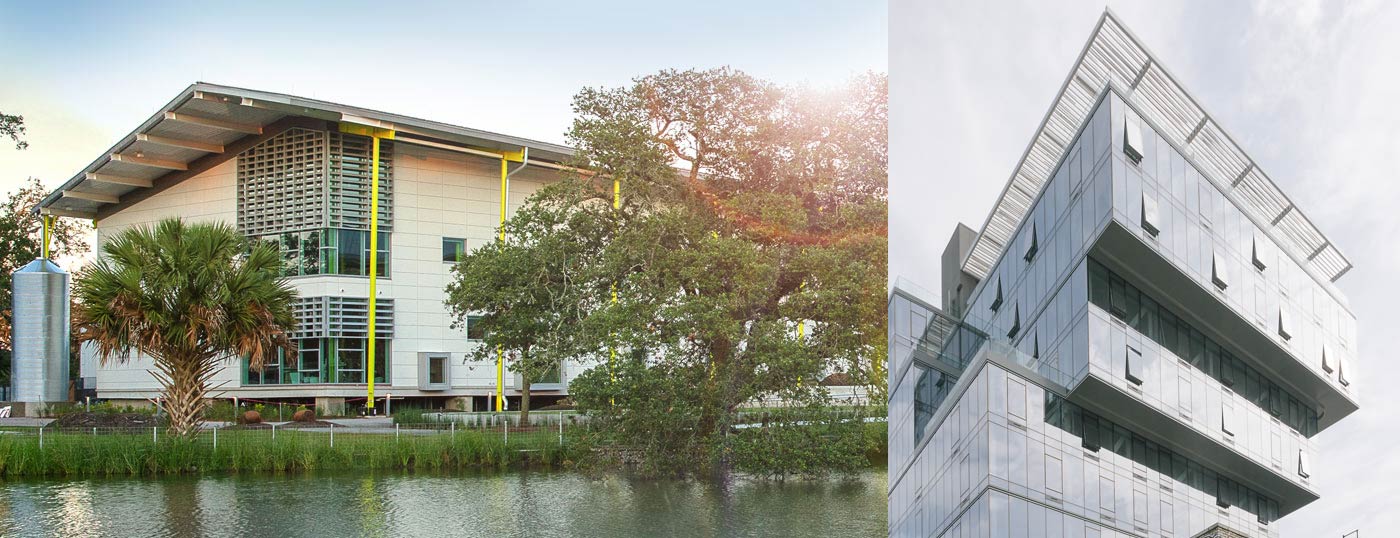
Photo credit: © 2019 Neil Alexander
Delays, setbacks and obstacles are an accepted part of business life. Things happen. Unforeseen circumstances can throw anyone for a loop. That’s certainly the case in an industry as complex and involving as many moving parts as building construction.
Proactive, informed and forward-thinking project teams can blunt the effects of situations that threaten construction timelines. Whether it is adverse weather, congested locations, potentially dangerous building environments or historic structures that require special care, detailed planning and the right building system—and supplier—can turn a challenging construction site into a manageable situation.
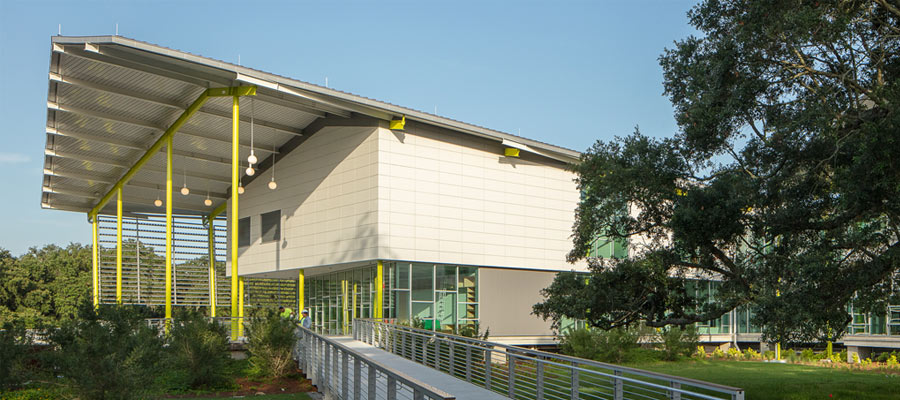
Photo credit: © 2019 Neil Alexander
Louisiana Children’s Museum looks serene and peaceful now, but weeks of rain during early construction created muddy, difficult working conditions.
There’s a level of irony in the situation builders faced during the construction of the new Louisiana Children’s Museum in the spring of 2019.
Fourteen years earlier, the museum postponed expansion plans when Hurricane Katrina struck New Orleans. After a 10-month cleanup, museum leadership decided to relocate. Fast forward to 2019, when construction on the new museum was in full swing on 8.5 acres of land in the city’s picturesque City Park. As a planned fall grand opening approached, extreme weather again put the museum’s plans in jeopardy.
“It was quite a muddy mess,” says Trent Fowler, Specialty Deck Project Manager at New Millennium. “It’s hard to keep a project on time whenever you have that much rain. There were a lot of rainout days.”
“We had equipment disappearing in the mud like it was quicksand,” says Allison Stouse, the museum’s project director. “I don’t think I’ve seen anything like it.”
Stouse says work crews were “constantly bringing in more aggregate to see if they could shore up enough access to whatever it is they were working on.”
“It was probably one of the hardest working conditions they’ve ever overcome.”
Fowler needed to figure out how to get 1,075 panels of New Millennium Super Versa-Dek® 6.5 LS Acoustical architectural decking to the site for the museum’s roof and also Composite Floor Deck 3 Cellular Acoustical for the interior.
To avoid the mess during rainy periods, Fowler coordinated with the site’s deck erection superintendent to ensure only necessary materials were delivered. At the same time, the New Millennium plant in Memphis increased deck output to help make up for lost time. When the weather cooperated, crews worked multiple areas at the same time, and Super Versa-Dek® panels were assembled concurrently with erection. Fowler, based in Columbia, S.C., also visited the New Orleans site several times and called the foreman overseeing deck installation daily.
The grand opening of Louisiana Children’s Museum happened as scheduled, thanks in part to the flexibility of New Millennium and the ability to quickly erect Super Versa-Dek® and Composite Floor Deck 3 Cellular Acoustical roof and floor deck.
The dedication of Fowler and New Millennium was not overlooked. “The contractors are to be completely commended for working through that [situation],” Stouse says.

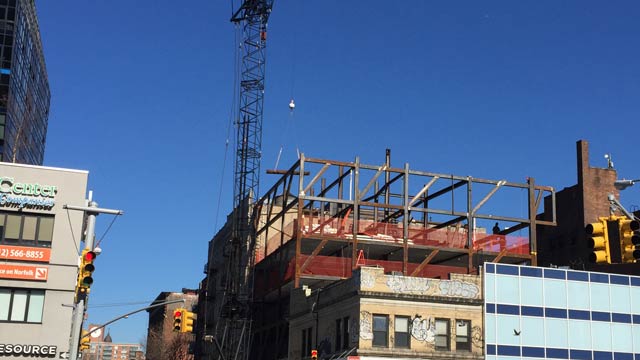
The New Millennium project management team coordinated on-time steel deck deliveries to meet the hectic construction schedule for a New York City condo development. This was accomplished even with the constraint of using a portable crane on-site just once a week due to traffic concerns.
Like natural landscapes, urban areas present their own construction challenges, chief among them being congested areas and the need to be as least disruptive as possible to residential and business activities. New Millennium recently supplied Deep-Dek® Composite for two projects in urban areas that required strategic scheduling and delivery.
In New York City, a 12-story mid-rise condominium development at 100 Norfolk St. on the Lower East Side proved to be a logistical challenge. The neighborhood experiences heavy traffic along the nearest cross street, 8-lane Delancey Street. Norfolk Street, on the other hand, is a one-lane, one-way street with metered parking on each side. New Millennium was tasked with coordinating multiple on-time deliveries of the Deep-Dek® Composite 4.5 required for the project while adhering to stringent limitations.
“The builder needed to use a portable crane which could be brought on-site only once a week because a permanent crane would have blocked narrow Norfolk Street,” says Marty Williams, Design Development Manager for New Millennium. “Hats off to our project management team for coordinating the steel deck deliveries.”
A similar situation played out in Miami, where the iconic, mid-rise Plymouth Hotel was undergoing a much-needed renovation. Located in bustling Miami Beach, project site access would be limited, and deliveries would need to be completed quickly to avoid disrupting the area. New Millennium helped in coordinating numerous just-in-time deliveries of long-span composite floor systems featuring Deep-Dek® Composite 7.5 and Deep-Dek® Composite 4.5 for the additional floor and balconies.
Healthcare facility projects are uniquely challenging. Hospitals in particular are busy and crowded, and there is a paramount need to avoid disturbing operations or patients on-site. That was true with the expansion of Presbyterian Hospital’s cancer center in Charlotte, N.C.
To meet the needs of the hospital, staging and logistics had to be carefully orchestrated with multiple just-in-time deliveries of Deep-Dek® Composite 7.5 panels to keep the area around the facility free of congestion. The last thing anyone involved wanted to do was block ambulance access to the hospital or create an unpleasant experience for employees or visiting family members.
For the structure itself, New Millennium worked with Diversakore® and fabricator Macuch Steel Products to produce a lightweight composite frame. Weight was a driving factor because the four-floor expansion was being constructed atop an operational cancer center. Quick and efficient construction was imperative, since patients and staff occupied the floors below. On an accelerated schedule, the total project took only 28 months to complete, saving more than $1 million in operational and construction costs. The four-floor frame was erected in just 16 weeks.

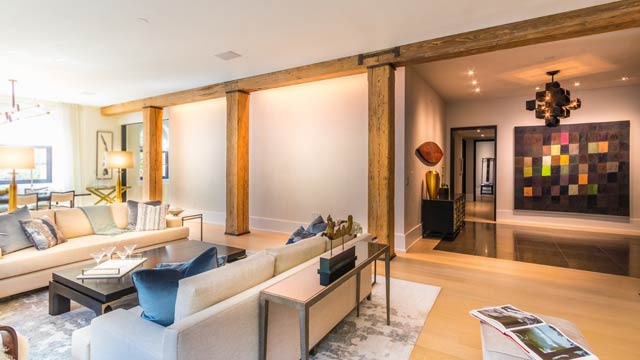
To prevent damage to the historic factory being converted to condos, floor decking was delivered through the building’s windows. Workers then carried the lightweight panels into position without the use of heavy equipment.
Back in Miami at the Plymouth Hotel renovation, a secondary challenge involved protecting the wood floors of the three-story hotel while adding a fourth floor. The hotel is integral to the art-deco architectural style of the city, and preservation of the original appearance was important to the owner. The existing flooring consists of wood installed in 1940, so shoring during the concrete pouring was not considered. The weight of temporary support columns would no doubt damage the floors.
To avoid shoring, the project required a long-span composite floor system capable of spanning 20 feet that was strong enough to support the concrete pour. That led to Deep-Dek® Composite 7.5 with 18 gage steel. Deep-Dek® Composite can achieve unshored pours up to 22 feet.
A recent makeover of an even older structure in the Tribeca neighborhood of New York City put the project team to the test.
New York developer Metro-Loft, ODA Architects and GACE Consulting Engineers envisioned a former bookbindery built in 1883 as a multi-story residential facility with 53 luxury condominiums. However, the seven-story, mid-rise was showing its age. The sagging wood floors required replacement, but the wood beams and columns would remain.
Deep-Dek® Composite was ideal for the bold new vision for the building while also preserving some of its original elements. Workers replaced the floor in stages, with floor sections arriving via just-in-time deliveries to cut down on traffic and eliminating the need to brace adjacent walls. A crane lifted the bundles of steel decking through windows on each floor to prevent damage to the historic building. Workers carried the lightweight floor panels into position and installed them without the use of heavy equipment.
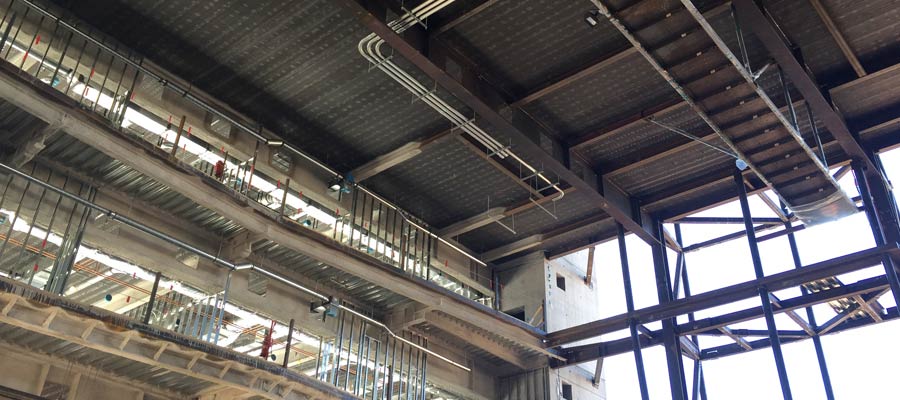
The massive, open-learning space at the University of Arizona Health Sciences Innovation Building was framed using long-span composite floors to create thin slabs set on 80-foot-long plate girders. Shoring during floor construction was not an option, so New Millennium devised a creative solution.
Sometimes ambitious building design necessitates unconventional thinking. The construction of the state-of-the-art University of Arizona Health Sciences Innovation Building in Tucson, Ariz., is a prime example.
The massive, three-story open-learning space in the center of the 220,000-square-foot structure was framed using long-span composite floors. To bring this design to life, a unique challenge had to be addressed: Shoring during floor construction was simply not feasible due to the cost and safety risks associated with staging that would require up to 60-foot-tall support towers.
The ideal floor system had to have visual appeal—since it would be left architecturally exposed—and the strength to support heavy superimposed loads. The 85-foot-by-25-foot bays had to control floor vibration below the threshold suitable for research environments.
“To meet all these requirements, Deep-Dek® Composite 6.0 Cellular Acoustical was chosen. The floor system could span 24.5 feet between 80-foot-long plate girders,” Fowler says. “The deck alone had sufficient strength to support construction loads (workers, equipment, and wet concrete) over the 24-foot-long unshored span. Deck deflection, however, would exceed limits outlined in current design specifications.”
To limit deflection, continuity plates were installed that bridged the deck ends on opposing sides of the girder beams. These tension plates helped create a multi-span deck installation resulting in additional stiffness, which eliminated shoring. The plates fortified the deck during construction, supporting workers and the initial pouring of a 2-inch-deep regular-weight concrete cover. After the concrete cured, the composite floor supported its self-weight and the weight of workers who then poured an additional 3 inches of concrete.
The flexibility of the New Millennium long-span composite floor system along with a willingness to think outside the box made the project a success.
New Millennium specialists work with our clients to ensure smooth project delivery. Contact us today.
Building a better steel experience